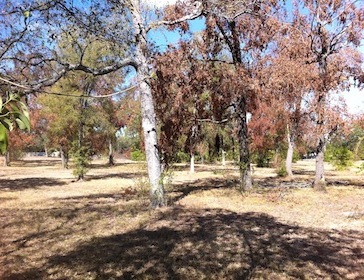
Brown trees near Brays Bayou in Houston's Texas Medical Center are among millions across the state stressed by record heat and drought.
Everyone already knows it was really hot in Texas this past summer, even by Texas standards.
Last month, the National Weather Service declared that Texas had the hottest-ever summer – based on the average June-August temperature – in U.S. history. The agency has posted some city-specific figures online that put an exclamation point or two after that finding.
The agency published data for 19 Texas cities in all parts of the state – Abilene, Amarillo, Austin, Brownsville, College Station, Corpus Christi, Dallas-Fort Worth, Del Rio, El Paso, Houston, Midland, Lubbock. Lufkin, San Angelo, San Antonio, Tyler, Victoria, Waco and Wichita Falls.
Sixteen of the 19 had their hottest all-time summer average temperatures since record-keeping began in the 19th century. The three that did not were Brownsville (eighth hottest), Corpus Christi (third hottest) and El Paso (second hottest).
As Houston Chronicle science writer Eric Berger has noted on his blog, four Texas cities had average summer temperatures of 90 or above this year – the first time any Texas city’s average has ever been above the 80s.
The four cities with 90-plus averages were Wichita Falls (91.9), Dallas-Fort Worth and Waco (90.5) and Tyler (90.2)
Berger’s terse observation:
Such an average temperature would imply highs of 100, and lows of 80.
[…]
As for that previous record of 89.2 degrees [Dallas-Fort Worth’s summer average in 1980], a total of seven Texas cities broke it during this ridiculously hot summer.
Let’s hope this is not the new normal.
The weather service also reported that 16 of the 19 Texas cities (all but Brownsville, El Paso and San Antonio) have recorded their largest numbers of days with temperatures of 100 or higher this year, based on readings through Sept. 29.
None of the 19 cities had previously recorded more than 79 days of 100-plus days (Wichita Falls’ previous record, set in 1980).
This year, seven cities had 81 or more 100-plus days:
- Abilene, 81 days (previous record: 46 days in 1934),
- Austin, 90 days (69 days in 1925),
- Del Rio, 85 days (78 days in 1953)
- San Angelo 100 days (60 days in 1969),
- Tyler, 81 days (47 days in 1998),
- Waco, 90 days (63 days in 1980),
- Wichita Falls 100 days (79 days in 1980).
Nine cities set or tied records for their largest numbers of consecutive 100-plus days:
- Austin, 27 days (previous record, 21 days in 2001),
- Houston, 24 days (14 days in 1980),
- Midland, 14 days (14 days in 1998),
- Lufkin, 26 days (17 days in 1944),
- San Angelo, 28 days (27 days in 1912),
- Tyler, 46 days (20 days in 1998),
- Victoria, 24 days (16 days in 1911),
- Waco, 44 days (42 days in 1980),
- Wichita Falls, 52 days (42 days in 1980).
John Nielsen-Gammon, the state climatologist and Texas A&M University professor, in comments during the summer to Texas Climate News, explained how hotter temperatures – which he says are already partly resulting from global warming – aggravate droughts like Texas’ current, record-setting dry spell:
It’s clear … that when Texas is in a drought, global warming will make it worse. Higher temperatures lead to more evaporation during a drought, more rapid drying of the soil, and perhaps a stronger feedback loop whereby the dry weather prevents thunderstorms and perpetuates the drought during the summer. At the same time, more evaporation and more population means greater water demand and larger reductions in streamflow and inflow to reservoirs. So global warming has already amplified the impacts of the current drought.
– Bill Dawson
